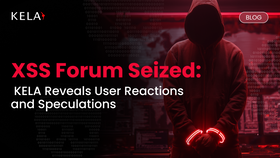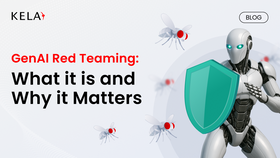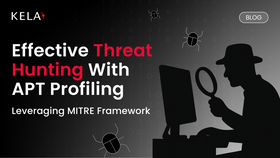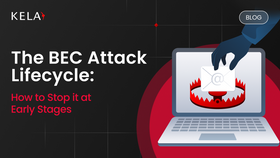Building Your Ransomware Response Plan: Step-by-Step Guide
A ransomware response plan is a must-have for any business. It provides a clear, stage-by-stage guide from detection to recovery to minimize damage and get operations back online fast.
Published October 20, 2025
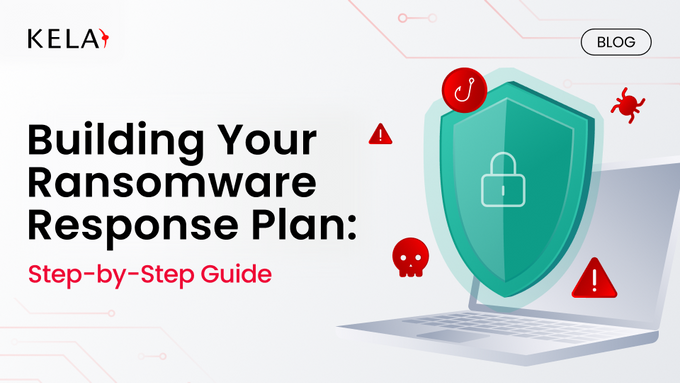
Ransomware attacks have become one of the biggest threats facing businesses today. They don’t just lock files or demand payment; they disrupt entire operations, expose sensitive data, and cause long-lasting reputational harm. For many organizations, recovery is not just a technical process but a full-scale business challenge that can take months, sometimes years, to fully overcome. That’s why a ransomware response plan is no longer something to consider—it’s a necessity.
In this blog, we’ll walk through what a strong plan should look like, from the moment an attack is detected through to recovery and post-incident analysis.
» Protect your business from ransomware today: Try KELA for free
The Broad Impact of a Ransomware Attack
Ransomware strikes when organizations are least prepared, causing damage that extends far beyond IT systems. Businesses face operational downtime, data loss, and exfiltration.
Regulatory noncompliance becomes a pressing issue, with fines and lawsuits following extended recovery times that often stretch well over a year. What begins as an IT issue quickly turns into a full-scale business crisis that disrupts continuity, undermines trust, and invites legal scrutiny.
Why Relying on Single Defenses is Risky
Depending on backups, cyber insurance, or endpoint protection alone creates dangerous blind spots:
- Backups may be corrupted, deleted, or too slow to restore, and they do nothing to prevent exfiltration.
- Cyber insurance often excludes ransomware coverage, imposes high deductibles, and never compensates for reputational damage.
- Endpoint protection can fail as attackers exploit legitimate tools and evolve their tactics to bypass defenses.
This is why a layered strategy is essential. Effective resilience combines:
- Preventive controls: cyber hygiene, training, MFA, segmentation, clean configurations.
- Detective controls: monitoring, analytics, threat intelligence.
- Recovery controls: tested offline backups, incident response planning.
» Here's everything you need to know about KELA's Cyber Intelligence Platform
The Blind Spots Exposed by Real Incidents
Organizations that survive ransomware often recognize gaps too late. Some find their incident response plans encrypted and inaccessible. Others discovered backups were incomplete, corrupted, or deleted by attackers, crippling recovery efforts. The Colonial Pipeline attack revealed how ransomware in a billing system could shut down critical infrastructure.
Common blind spots include:
- Underestimating ransomware’s full scope—data extraction and credential theft, not just encryption.
- Failing to test communication strategies, adding chaos during an already devastating event.
- Lacking offline response plans and air-gapped backups.
To reduce these risks, organizations must test plans in tabletop exercises, keep them offline, implement strong backup isolation, and conduct root cause analysis.
» See our complete guide to combating ransomware
How Sector, Size, and Regulations Shape Response Plans
The design of a ransomware response plan is never one-size-fits-all:
- Industry sector: A healthcare provider protecting patient records faces very different risks than a manufacturer or financial institution. Attackers tailor their methods to data value and system sensitivity.
- Organizational size: Larger enterprises may require cross-departmental coordination, while smaller ones often depend on outside consultants or cyber insurance as their first exposure to risk management.
- Regulatory environment: Frameworks like CCPA, GDPR, HIPAA, and OFAC define obligations for breach notifications, ransom payments, and compliance.
» Learn more about how ransomware operators gain access
Breaking Down the Core of a Ransomware Response Plan
1. Initial Detection & Activation
This stage is all about recognizing an active ransomware attack and immediately activating a pre-defined response plan. It requires rapid notification of key personnel and the establishment of secure, alternative communication channels.
The primary teams responsible are the IT security team, the incident response (IR) team, and senior management.
Best practices for effectiveness
- Conduct frequent, multi-level tabletop exercises, ideally quarterly, with technical staff and executives. These simulations help to test the plan in a low-stakes environment.
- Store your entire ransomware response plan offline, in a secure and easily accessible format (e.g., printed copies or on air-gapped USB drives), since your network and shared files may be unavailable.
- Ensure all employees receive strong security awareness training, with a focus on recognizing phishing attempts, as human error is a common entry point for attackers.
Remember: Never engage with the attackers or visit the dark web address in the ransom note. This could trigger a countdown on the ransom or escalate their demands by confirming you've seen the note.
» Learn more about how hackers gain entry to your systems
2. Containment & Initial Assessment
The primary objective of this stage is to stop the ransomware from spreading and quickly assess the extent of the damage. This involves isolating infected machines and segments of the network. A rapid forensic analysis is conducted to identify the ransomware strain and its immediate impact.
This stage is primarily handled by the incident response team, network administration, and often, an external incident response firm.
Best practices for effectiveness
- Immediately isolate all suspected machines by unplugging them from the network or disabling their wired and wireless connections.
- Begin forensic data collection on affected devices by creating memory and hard drive images. This is crucial for capturing evidence like decryption keys or attacker tools.
- Quickly identify the ransomware variant. Knowing the specific type of ransomware is vital for understanding its behavior and potential for a negotiated decryption key.
- Rigorously validate the integrity of your backups with a dry run to ensure they are not corrupted and can be restored.
Pro tip: Do not restart, shut down, or make any changes to files on infected systems. This will destroy volatile data in memory and could hinder a forensic investigation.
3. Decision Making & Communication
This critical stage involves the decision of whether to pay the ransom and the creation of a clear internal and external communication strategy. It requires a thorough understanding of legal implications, business impact, and close coordination with legal and cyber insurance teams.
The main players are senior management, legal counsel, PR crisis firms, and ransomware negotiators.
Best practices for effectiveness
- Thoroughly vet the decision to pay a ransom, considering legal constraints (e.g., OFAC sanctions), business risks, and the high probability of data exfiltration.
- Develop a comprehensive crisis communications plan that outlines who to contact (employees, clients, authorities), what to say, and when to say it.
- Engage legal counsel early to understand breach notification laws and protect communications under legal privilege.
Take note: If the attack involves exfiltrated critical patient data (in healthcare) or national security information, the decision to pay may become a deviation from standard policy. In such high-stakes scenarios, an organization might engage specialized negotiation experts.
4. Recovery & Restoration
This stage involves the technical process of restoring affected systems and data. It includes erasing malware, resetting credentials, and rebuilding systems from clean backups. The key responsibilities fall to the IT operations team, IT security, and external recovery specialists.
The goal is to bring the business back to normal operations as quickly and safely as possible.
Best practices for effectiveness
- Prioritize the recovery of critical systems based on their Business Impact Analysis (BIA) to minimize operational downtime.
- Test all restored systems in an isolated environment before reconnecting them to the main network.
- Reset all passwords and credentials that may have been compromised and ensure MFA is enabled wherever possible.
- Adhere to the 3-2-1 backup rule (3 copies of data, on 2 different media, with 1 off-site/offline) to ensure a reliable recovery source.
Pro tip: Do not restore systems until you have confirmed the vulnerability that allowed the attack has been patched. Restoring without remediation will likely lead to re-infection.
» Did you know? Ransomware groups are now selling network access directly
5. Post-Incident Analysis & Hardening
The final stage is a thorough post-mortem of the incident. It focuses on identifying lessons learned, documenting what went well and what went wrong, and making long-term improvements to prevent future attacks.
This phase is collaborative, involving senior management, the IT security team, the incident response team, and legal counsel.
Best practices for effectiveness
- Conduct a blameless post-mortem to encourage all parties to share information honestly without fear of retribution.
- Focus on remediating the root cause of the attack (e.g., an unpatched server, a phishing email) to prevent a recurrence.
- Implement a Zero Trust Framework to enforce multi-factor authentication and strict access controls across the organization.
- Update your incident response plan and other security policies based on the lessons learned from the attack.
Take note: Do not assume you can return to the "status quo." Use the incident as an opportunity to fundamentally enhance your cybersecurity posture. Avoid saving the updated response plan only in an online location.
» Learn more: The ransomware path from start to end
How Often Should You Test Your Plan?
A ransomware response plan should be a living document, not a static one. To remain effective against evolving threats, it should be reviewed and tested at least semi-annually, with quarterly tabletop exercises being the ideal.
The plan must also be updated whenever there are significant changes to the organization's personnel, roles, network infrastructure, or security tools. Incorporating the latest threat intelligence into these exercises helps teams prepare for new and emerging attack techniques, ensuring the plan remains relevant and robust.
Measuring the effectiveness of a response plan is crucial for demonstrating its value and identifying areas for improvement.
» Not convinced? Here are the reasons you need cyber threat intelligence
Key Metrics and Indicators Include:
Mean Time to Detect (MTTD): The average time it takes to identify a malicious threat within the network. A lower MTTD indicates a more effective detection system.
Mean Time to Respond (MTTR): The average time from initial detection to the successful containment of the threat. A lower MTTR demonstrates a swift and decisive response capability.
Recovery Time Objective (RTO): The maximum tolerable length of time a system can be down. The goal is to consistently meet or beat the RTO set in your business continuity plan.
Data recovery rate: The percentage of critical data successfully restored from backups or decryption. A higher rate indicates reliable backups and a robust recovery strategy.
Cost of incident: The total financial impact of an attack, including downtime, recovery costs, and potential fines. A lower cost over time reflects a more efficient response.
» Worried you might be in danger? Here's how to know if you are an ideal ransomware victim
Ransomware Response Plan: A Proactive Stance
Ultimately, proactive readiness is your best defense against ransomware. We at KELA Cyber can help you address these challenges by providing actionable threat intelligence directly from the cybercrime underground. Our platform gives you early warning signs by continuously monitoring for subtle anomalies like stolen credentials, data exfiltration, or unusual network activity long before a ransom demand even appears.
This deep understanding of adversary motivations and tactics allows you and your business to proactively adapt your defense strategy, turning passive security into a critical component of your risk management.
» Ready to begin? Set a FREE session with our experts
FAQs
What is the most important first step when a ransomware attack is detected?
The most critical first step is to immediately activate your ransomware response plan and isolate all infected systems from the network. This prevents the malware from spreading and minimizes damage.
Should we pay the ransom to get our data back?
The decision to pay is complex and should be made in consultation with legal counsel and your cyber insurance provider. While paying might seem like the fastest option, there is no guarantee you will receive a working decryption key, and it can encourage future attacks.
How often should we test our ransomware response plan?
A ransomware response plan should be a living document, not a static one. You should test it with tabletop exercises at least semi-annually, if not quarterly. This ensures your team is prepared for evolving threats and that the plan remains effective.
Can our backups be trusted during a ransomware attack?
Not always. Ransomware attackers often specifically target and corrupt backup systems. It is crucial to follow the 3-2-1 backup rule (three copies, two media types, one off-site) and regularly test your backups to ensure they are clean and functional.


